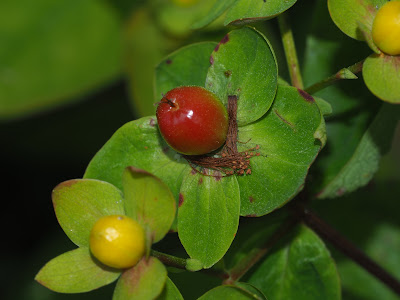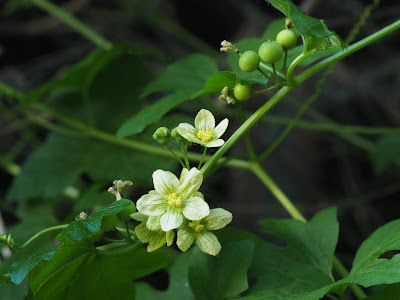Common name: Tutsan
Scientific name: Hypericum androsaemum 漿果金絲桃
Genus: Hypericum 金絲桃屬*
Family: Hypericaceae 金絲桃科, St. John's wort family
Remarks*: The generic name Hypericum comes from "Hyper" and "Eikon" in Greek, meaning above and picture respectively. It refers to the traditional hanging of the plants above religious pictures, to ward off evil, when they were harvested on St John the baptist’s day (June 24th – midsummers day). And it is also the reason why the family name is called St. Jons's wort.
Origin: native
Date: 15th June
An erect, branched, half-evergreen, shrubby perennial, can reach up to 100 cm. Plant is more or less shrubby. Stems are woody.
The flowering shoot.
Leaves are opposite, without stalks. Photo enlarged below to see the details of the stalk.
 Stem with two raised lines
Stem with two raised lines. (could only see one line above - see the ridge indicated by the blue arrows)

Photo taken at another location. It is enlarged below to see the details of the stem. (26th June)
could be seen clearly
on the stem in the above photo. (the blue arrows indicate the location of the ridges.) (26th June)
(vs stems with 4 ridges in
Hypericum hircinum, stinking tutsan)
Leaves are glabrous and 10 cm long. Leaves are not smelling of goats when crushed. (vs are smelling strongly of goats when crushed in Hypericum hircinum, stinking tutsan)
The underside of the leaf.
Part of the few-flowered inflorescence.

Flower bud.
Flower is about 2 cm across. (vs 3 cm across in Hypericum hircinum, stinking tutsan)
 Stamens are as long as petals
Stamens are as long as petals. (vs stamens are longer than petals in
Hypericum hircinum, stinking tutsan)
Side-view of the flower. Stamens are as long as petals. Photo enlarged below to see the details of the style.
Numerous stamens,
3 styles. Ovary could be seen clearly above.
Style is shorter than the stamens.
(vs style is longer than stamens in
Hypericum hircinum, stinking tutsan)
(vs 5 styles in
Hypericum calycinum 大萼金絲桃, rose-of-Sharon)
The underside of the flower, showing the uneven sepals. (the sepals at 9 and 6 o'clock of the flower above are clearly thinner than the other sepals.)
Red fruit with dropping stamens aside. It would turn black afterwards.
























































